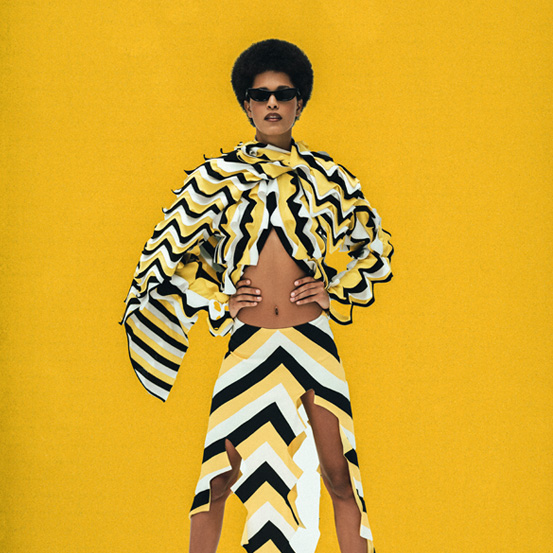There is nothing like the pleasure that only shopping can bring. But faced with the frightening possibility of a serious addiction, alternatives are more than welcome. What's beyond consumerist pleasure?
There is nothing like the pleasure that only shopping can bring. But faced with the frightening possibility of a serious addiction, alternatives are more than welcome. What's beyond consumerist pleasure?
My name is Pedro, and I am a shopping addict. Let's skip the Alcoholics Anonymous-style introductions, the typical "hellos" recited in communion. Calling it a "problem" sounds less intense, but my addiction is something I do not take seriously. The lightness with which I face it is not shared by some of my friends, particularly those who do not follow the fashion industry with the same cult-like religiosity, for whom paying more than twenty pounds for a pair of jeans is unthinkable.
Let it be clear that this "problem" does not assume serious proportions. If anything, it resembles a hobby, even if a very expensive one. But this extracurricular activity is widely normalized, and easily justifiable. Who does not want to feel confident in what they are wearing? Besides the inherent futility that the fashion world speaks to, there is an immediate chemical reaction as soon as we buy something. An instant pleasure that appeals to a hedonistic tendency. There's magnetism in a good shopping spree. A sinful delight in obtaining the perfect jeans. Or the shoes we have been dreaming of for months. Or the accessory that, as if by magic, complements our entire closet. Even though I write like a true addict, I assure you: I only teeter around the edge of the pathological (exactly what an addict would say, I know). Despite my lack of seriousness, I wonder where this instinct originates and, above all, if there is a solution to the vicious cycle of boredom, purchase, happiness, boredom, purchase, happiness...
Let's start with the usual excuses that remove the subject from the problem. These days it's hard not to be a shopaholic. Social media, for one, is an ether where consumerism is more than usual; it is mandatory. The universal rule is that whenever we post, the outfit should be new, preferably following the viral trend of the week. This dogmatic expectation installs a sense of urgency. Even though we know that the style of clothing we want to acquire won't last beyond next season (at best), we can't deny that we want to be included.
It doesn't help that as soon as we entertain the idea of purchasing something we know we don't need, the Internet makes sure we never forget it. The well-known cookies from every website, which we impatiently accept every time we enter any online store, outline our cyber-travel as if they were literal crumbs. The allusive algorithms know what we covet. They memorize our guilty pleasures. They know we've been eyeing the same Marni loafers for months. And, in a scheme that resembles medieval torture, present them in front of us at every opportunity they get. These tests of our self-control are reinforced by the promotions that, although daily, are advertised as one-time opportunities in the life of a hedonistic consumer.
We should not deceive ourselves into thinking that consumerism is a modern issue. The desire to purchase what we want, regardless of necessity, is older than the arrival of capitalism. According to research conducted at the University of San Francisco, this urge is part of our survival instinct. The study, led by psychologist Ryan Howell, found that the spirit of consumerism goes back to the beginning of mankind. At that time, scarcity was a daily reality, and we developed the reflex to acquire everything we wanted in response since the odds were that it would be our only chance to do so. This is the instinct that clever online advertisements attempt to appeal to when they claim that the 20% discount on the new collection only lasts for 24 hours (a trick that any shopaholic who knows that anything below 30% is simply not worth it can easily see through).
Even if, in a state of delirium, we try to blame a primitive trend as the rationale for our "problem" (the quotation marks are essential), common sense does not permit it. The issue is more complicated than this excuse: purchasing makes us feel good and stimulates an amoral sense of happiness within us. Retail therapy works. The reason for its efficacy is well-studied and a consensus has been reached. The act of purchasing restores a sense of control in our lives. Needless to say, this “therapy” is far more expensive than any session with a psychologist.
We cannot reduce the allure of a good purchase to the esoteric need for control that often serves as a scapegoat for all of our unhealthy habits. Spending money on something we want introduces a sense of novelty into our otherwise monotonous daily lives. However, the euphoria of a purchase has a perishable shelf life that expires as soon as we become accustomed to it. Despite believing that we have outgrown childish tendencies, we are essentially just kids who want a new toy. Since the 1970s, the advertising industry has recognized that to sell unnecessary products, it is critical to tap into our puerile greed. Modern marketing employs complex strategies to entice us to make purchases. Psychological theories have influenced the creation of advertisements that function similarly to Pavlov's bell, conditioning us like salivating dogs."Drink this soda, and you'll be surrounded by friends." "Buy this perfume, and you'll be as desirable as Zendaya." Our deepest desires are commodified, and happiness is sold cheap.
The fashion world elevates this notion and advertises utopian versions of who we are. Its delusion intercepts reality. We are convinced that for a mere portion of our income, we can become who we always wanted to be. Marni's loafers are not merely shoes. They are a materialization of a fictional person who is cool in a desirably effortless way. "It's not just a shirt or a skirt; when I walk through a store, I see different versions of myself. What if I started dressing like this? What would my life be like? It's not about objects; it's about how we feel about ourselves." This is how Sophie Percival, British artist (and self-proclaimed shopaholic), describes the root of consumerism, elaborating, "Ultimately, it's all about the happiness that a piece causes us; that's what we chase." During a video call, the artist and I almost finished each other's sentences. We won't keep putting it off any longer; now, the meeting of (not so) anonymous consumerists can begin.
What I was looking for from Percival is not just someone with who I can empathize but lessons from someone who has found a healthy alternative to her impulses. In 2022, the multidisciplinary artist started a project that channels consumerism into creativity - the British woman recreates the bags she covets with clay, creating replicas of her favorite pieces. "I have always loved luxury bags; to me, they represent independence and freedom." Her pieces were the way she found to moderate her impulsive spending. "Last year, I broke my shoulder and had all this time at home doing nothing. The impulses to buy were constant." To avoid emptying her savings in the two months she had to stay home, Percival went looking for alternatives. "I asked myself if seeing other people buying would reduce the need I felt to do the same. To my surprise, it helped. I started frequently watching videos of hauls or influencers browsing their closets." It was through one of the latter that her eureka moment occurred. "In one of those videos, there was Gucci's Ophidia purse in the background. I thought 'I need that bag,' but it's a tiny bag. If I got it, I would probably never wear it. I just wanted it for display, like that Youtuber." That's how the idea of creating ceramic versions of her favorite purses came about. From Fendi's Baguette to Prada's Re-Edition, Percival creates the world's most coveted luxury pieces. Leather is replaced with clay, significantly more durable.
"This project is not supposed to be a critique of consumerism; it's more complicated than that. I derive a lot of pleasure from the shopping I do, but at the same time, it's exhausting." The artist explains the project as a kind of therapy (rather less expensive than retail therapy). "Producing these bags was the way I found to deal with some of my impulses." What Percival shows us is that there is a way to channel consumerism into something productive. By injecting her creative instincts, the artist has turned her cravings into something she is proud of. "I found something that allows me to have all the euphoria of when I buy a bag without having to feel the hangover and guilt."
Percival's words are comparable to sacred scriptures. But even though she has found an alternative to her impulses, she confesses that she doesn't shy away from satiating some of her desires. "I have a few rules that I follow when I spend money on fashion: I don't buy anything that costs more than a certain limit, and I never, ever shop online after nine o'clock at night." These are words from someone who has overcome the impulsiveness of her hedonism. Am I cured? No. Inspired? Definitely. I have already ordered the clay.
Originally translated from The Pleasure Issue, published May 2023.Full stories and credits on the print issue.
Most popular
.jpg)

Sapatos de noiva confortáveis e elegantes: eis os modelos a ter em conta nesta primavera/verão
24 Apr 2025

Relacionados

Os benefícios de caminhar durante as primeiras 3 horas do dia para produzir vitamina D e dormir melhor
29 Apr 2025




